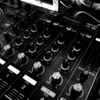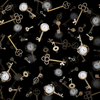Quarterly Journal 49-4
In This Section
The AIPLA Quarterly Journal, a publication of the American Intellectual Property Law Association, is housed at the George Washington University Law School and is edited and managed by an Editorial Board of intellectual property experts and a staff of law students under the direction of the Editor-in-Chief, Professor Joan Schaffner.
The Quarterly Journal is dedicated to presenting materials relating to intellectual property matters and is published four times per year. Editorial Board members (all of whom are lawyers) are selected based upon demonstrated interest and experience, and student staff members are selected from the students of the GWU Law School.
 QJ 49.4 - COMMON TIME AND COMMON PROPERTY: HARMONIZING MUSIC COPYRIGHT LAW WITH WESTERN MUSIC THEORY AND CONVENTIONS
QJ 49.4 - COMMON TIME AND COMMON PROPERTY: HARMONIZING MUSIC COPYRIGHT LAW WITH WESTERN MUSIC THEORY AND CONVENTIONS
Clarissa M. Cashmore and R. Taylor Townes
COMMON TIME AND COMMON PROPERTY: HARMONIZING MUSIC COPYRIGHT LAW WITH WESTERN MUSIC THEORY AND CONVENTIONS
Safeguarding musical building blocks from the exclusive appropriation of one creator is essential to maintaining and propagating a robust body of creative works whose very existences depends on the free use of common property. This article will aid practitioners and judges in classifying and delineating common property from protectible expression. Using foundations of music copyright law and Western music theory and traditions, this article identifies and analyzes courts’ efforts to filter out common property to determine what is actionable appropriation.
Following a rudimentary Western music theory guide to acclimate novices, the analysis of what constitutes originality in composition begins with melody and its ancillary features, followed by harmony, rhythm, and the structure and sound selection of compositions. A discussion of the crucial role that selection and arrangement plays in these disputes will incorporate guidance from the Ninth Circuit 2020 case Skidmore v. Led Zeppelin, which the Supreme Court declined to review.
 QJ 49.4 - COPYRIGHT FOR DJS: A STATUTORY LICENSE TO LEGITIMIZE DJS IN STREAMING
QJ 49.4 - COPYRIGHT FOR DJS: A STATUTORY LICENSE TO LEGITIMIZE DJS IN STREAMING
Yunzhu (Izzy) Chen
COPYRIGHT FOR DJS: A STATUTORY LICENSE TO LEGITIMIZE DJS IN STREAMING
The disc jockey (“DJ”) field has historically been faced with copyright compliance issues, and the Covid-19 pandemic has intensified these copyright confrontations. When all in-person gatherings were on pause, DJs had no means to perform and connect to their audience other than through the streaming services. However, without a regulatory framework in place to legitimize DJing practice in streaming contexts, DJs have frustratingly found themselves in a dubious legal environment. Creative solutions are required to facilitate music licensing on an unprecedented scale in both audio and video formats and across a myriad of platforms. This Note recommends a legislative amendment to adopt a DJ blanket license in the form of a revised version of Professor Menell’s proposal to expand the § 115 statutory license to cover mixes and remixes. The revised blanket license that allows DJs’ use of copyrighted music in streaming will strike a balance between the rights holders’ interests in fair compensation and DJs’ interests in artistic expression and creation. To account for the compulsory nature, the interests of both sides and the established industry standards will inform tailored royalty payouts for various streaming scenarios.
 QJ 49.4 - A HARD TEST FOR SOFTWARE: DECODING AN IMPROVED ALICE/MAYO TEST FOR SOFTWARE-RELATED PATENTS IN THE FEDERAL CIRCUIT
QJ 49.4 - A HARD TEST FOR SOFTWARE: DECODING AN IMPROVED ALICE/MAYO TEST FOR SOFTWARE-RELATED PATENTS IN THE FEDERAL CIRCUIT
James W. Cowan
A HARD TEST FOR SOFTWARE: DECODING AN IMPROVED ALICE/MAYO TEST FOR SOFTWARE-RELATED PATENTS IN THE FEDERAL CIRCUIT
American patent law awards patent protection to innovations that—along with meeting other requirements—fall under a category of so-called “patent-eligible subject matter” and denies this protection to innovations falling under certain “ineligible” categories. In Alice Corp v. CLS Bank International, the Supreme Court built upon its prior Mayo decision and expanded the “patent-ineligible” categories to bar abstract ideas—an innovation essentially applying or reciting abstract ideas cannot enjoy patent protection. However, this creates a conundrum for software-related patents: Software can be fairly understood as a set of instructions to be executed by a computer, and this observation raises a critical question: Are innovations relying on software inherently abstract—and thus inherently ineligible for patent benefits? Curiously, the Supreme Court has held the answer to be “not necessarily.” Since Alice, lower courts have grappled with reconciling this discrepancy. The Federal Circuit—enjoying nationwide jurisdiction over patent issues—has applied Alice/Mayo and has nonetheless found patent-eligibility for software-related patents. This Note explores the relevant Federal Circuit cases to discern what really makes software abstract and thus patent-ineligible—at least in the Federal Circuit’s view. This Note further proposes AMST: The Alice/Mayo Software Test in order to give practitioners a greater insight into software-related patent analysis at the Federal Circuit. Specifically, the AMST proposes that software-related patents seeking to protect technological improvements in computer processing should focus on the effects of the improvement while those seeking to protect improvements on prior art’s capability by incorporating software should focus on the actual change in practitioner capability.
 QJ 49.4 - PATENT SUBJECT MATTER ELIGIBILITY AND MEDICAL DIAGNOSTICS: WHERE DO WE GO FROM HERE?
QJ 49.4 - PATENT SUBJECT MATTER ELIGIBILITY AND MEDICAL DIAGNOSTICS: WHERE DO WE GO FROM HERE?
Jessica Lehrman
PATENT SUBJECT MATTER ELIGIBILITY AND MEDICAL DIAGNOSTICS: WHERE DO WE GO FROM HERE?
Medical diagnostic devices play an increasingly important role in the advancement of modern medicine and promise to revolutionize the future with personalized therapeutics. Since the Supreme Court decided Mayo Collaborative Services v. Prometheus Laboratories (Mayo) in 2012, Section 101 jurisprudence has deprived many innovative, life-saving diagnostic technologies of patent protection. Since strong enforceable patents are the very lifeblood of innovation, Mayo has negatively impacted investment in the research and development of medical diagnostic technologies, and the life sciences industry at large.
This Note will review the current state of patent eligibility jurisprudence for medical diagnostics and explore potential avenues forward for incentivizing their development and commercialization. First, this Note explains the legal and policy considerations that form the basis of and drive modern patent law. It then focuses on the judicial exceptions and how their problematic application to modern scientific innovation has plagued the patent system for the past decade, as exemplified by the splintering of the Federal Circuit in Athena Diagnostics v. Mayo Collaborative Services.
Next, this Note examines potential pathways to afford medical diagnostics intellectual property (IP) protection, in light of recent case law, events, and IP trends. Part A explores how the patent community can reframe the ways in which we characterize and define diagnostic devices, to craft both patent claims and arguments capable of circumventing Mayo’s precedent. Part B explores potential administrative remedies available through the United States Patent & Trademark Office (USPTO) and Congress’ power to delegate rulemaking authority. Next, Part C explores legislative options for Congress to reform Section 101. Finally, in Part D, this Note explains how the state of patent eligibility has driven innovators to pursue trade secrets as an alternative form of IP protection, and the practical and policy ramifications of this growing trend.
Upcoming Events
-
.png?sfvrsn=9aa26827_1) 2026 AIPLA Virtual Corporate Practice Institute
2026 AIPLA Virtual Corporate Practice Institute
January 13 to 20, 2026 | Up to 360 Minutes of CLE
The Corporate Practice Institute is not a bootcamp. This program provides in-depth insight for in-house corporate counsel and agents to learn about wide ranging legal issues affecting their practice from experienced practitioners. It is designed for experienced in-house attorneys and new in-house attorneys learning to manage new corporate environments and challenges not taught in law schools or private practice. The Institute also helps private practice attorneys, especially associates, prepare for potential in-house career moves. The program also provides valuable networking opportunities to connect with each other and learn from each other's experiences. This online, CLE-program spans two half-days, from Noon – 5:00 pm Eastern and includes 3 one-hour education sessions and a networking session each day. -
 AIPLA CLE Webinar: Regulation, Risk & Resilience: The Nexus Between Professional Liability, Duty of Competence & Practitioner Well-Being
AIPLA CLE Webinar: Regulation, Risk & Resilience: The Nexus Between Professional Liability, Duty of Competence & Practitioner Well-Being
February 10, 2026 12:30 PM to 2:00 PM | Eligible for up to 90 Mins CLE
Mental health issues and substance use disorders can affect any practitioner, in any setting, and at any time. Left untreated, they can destroy careers and lives. This program will discuss where the legal profession currently stands in relation to the substantial challenges presented by untreated mental health issues and substance use disorders and examine the nexus between ethical competence under the USPTO Rules of Professional Conduct and practitioner well-being. This program will educate attendees on how to recognize the signs of an impaired attorney, how to approach the colleague and begin a conversation, and discuss the possible disciplinary and professional liability implications of an impaired practitioner’s conduct. In addition, the speakers will present best practices/effective risk management strategies, preventative measures, and proposed policy and well-being initiatives, that practitioners in any practice setting may implement to protect clients, themselves, and other firm members as well as save careers. -
.png?sfvrsn=fb5905da_1) 2026 IP Transactions Bootcamp
2026 IP Transactions Bootcamp
February 12, 2026
This in-person bootcamp is designed to provide practical insights and strategies for professionals working in intellectual property transactions. The day features a comprehensive agenda including: Panels and CLE Sessions: Learn about Working with Tech Transfer Offices, Strategies for successful collaborations between nonprofits and industry, and Protecting and monetizing an AI asset. Drafting and Negotiating Tips: Get practical advice on drafting and negotiating strategic collaboration and license agreements. Hands-on Workshop: Participate in a Mock licensing negotiation to put your skills to the test. Networking: Conclude the day with a dedicated Networking reception. -
2026 Patent Prosecution Boot Camp - Arlington, VA
March 4 to 6, 2026 | Up to 1235 minutes, including 60 Ethics minutes
Registration coming soon! The 2026 Patent Prosecution Boot Camp is a comprehensive, CLE-accredited seminar that includes instructional lecture-style sessions with practical tips on U.S. and international patent preparation and prosecution, as well as hands-on interactive workshops that will walk you through drafting claims and responding to office actions. -
-(1).png?sfvrsn=7a1054_1) 2026 Trade Secret Summit
2026 Trade Secret Summit
March 26 to 27, 2026
The AIPLA Trade Secret Summit is the leading trade secret conference in the nation, with speakers from across the spectrum of private practitioners, in-house counsel, government, and academia, as well as fantastic networking opportunities. CLE credits will be available.

